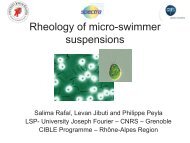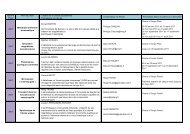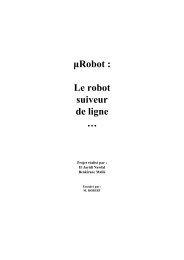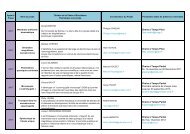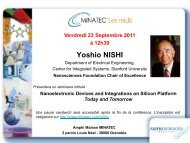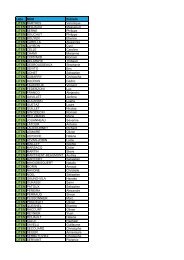2012 Thesis Prize Award Ceremony - Fondation Nanosciences
2012 Thesis Prize Award Ceremony - Fondation Nanosciences
2012 Thesis Prize Award Ceremony - Fondation Nanosciences
Create successful ePaper yourself
Turn your PDF publications into a flip-book with our unique Google optimized e-Paper software.
Dynamics of controlled actin network’s<br />
architecture<br />
Anne-Cécile REYMANN<br />
PhD of University of Grenoble<br />
iRTSV/PCV<br />
Laureate of the<br />
‘<strong>2012</strong> <strong>Thesis</strong> <strong>Prize</strong>’<br />
Actin networks are one of those fabulous self-organized<br />
biopolymers that sustain cell architecture while those<br />
perform highly complex mechanical transformations in<br />
order to achieve efficient morphogenesis, cell motility<br />
or any cell shape changes. Perpetual dynamics,<br />
organization, regulation or rapid reconstruction are only<br />
a few of the properties required for these morphological<br />
features which are supported by the actin cytoskeleton.<br />
During my thesis, I have developed different projects in<br />
order to tackle the problem of actin network dynamics<br />
and organization as well as the molecular mechanism<br />
at the origin of force production in biomimetic<br />
reconstituted systems. Stepping aside from the<br />
conventional actin based particles’ motility studies,<br />
one of the major innovations was to generate highly<br />
ordered auto-assembled actin motifs, finely tuned by<br />
the reproducible spatial control of actin nucleation<br />
sites by micropatterning. Moreover the presence of<br />
molecular motors, such as myosin, on these controlled<br />
systems allowed us to reproduce some of the cellular<br />
biomechanical processes of tension and contractility.<br />
A direct visualization of filaments demonstrates<br />
a spectacular myosin-induced actin network<br />
deformation and disassembly that depend on the<br />
original network architecture.<br />
Following an “orientation selection” mechanism such<br />
phenomenon could therefore play an essential role in<br />
the spatial regulation and scalability of expanding and<br />
contracting regions of actin cytoskeleton in cells.<br />
Ioan Mihai POP<br />
PhD of University of Grenoble<br />
Institut Néel<br />
Laureate of the<br />
‘<strong>2012</strong> <strong>Thesis</strong> <strong>Prize</strong>’<br />
Coherent quantum phase-slips in a<br />
Josephson junction chain<br />
The central result of my thesis is the observation<br />
of quantum phase-slips in Josephson junction<br />
networks. A phase slip is associated with the<br />
passage of a magnetic quasi-particle (a “fluxon”)<br />
through a Josephson junction chain.<br />
We have observed the quantum interference of<br />
phase slips, an effect predicted by Y. Aharonov<br />
and A. Casher in 1984. This is the electromagnetic<br />
dual of the well-known Aharonov-Bohm effect.<br />
We have also demonstrated that a chain of<br />
Josephson junctions, which is a complex<br />
mesoscopic object, can accurately be treated<br />
as a single quantum object, with few degrees of<br />
freedom.<br />
These results open the way for a wide range<br />
of possible uses of quantum phase-slips in the<br />
design of novel Josephson junction circuits, such<br />
as topologically protected qubits, frequencyto-current<br />
conversion devices or quantum<br />
simulators.<br />
http://ceremonie<strong>2012</strong>.eventbrite.com<br />
www.fondation-nanosciences.fr



